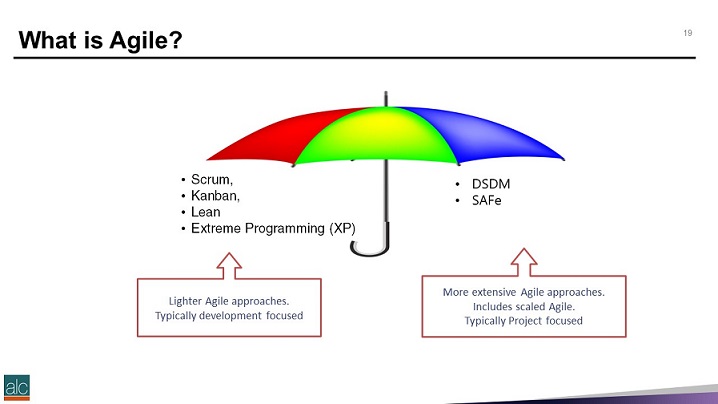Agile Project Management (AgilePM) offers a practical methodology for ensuring your teamwork rapidly and flexibly to deliver client requirements. From product quality and customer satisfaction to project ROI, control, and risk, you as the project manager need to be able to manage everyday challenges effectively. So how does agile help you address these issues?
1. Ensuring high product quality
The agile methodology is focused on testing, which is integrated into the cycle. Your team has numerous chances to inspect and correct designs or product iterations during the development cycle.
The just-in-time approach keeps product features relevant while allowing you a chance to ensure it’s as high quality as possible. Issues are kept fresh by the just-in-time iterative method, so your team can work dynamically to correct and improve while the concepts are still fresh in mind.
Agile emphasises automated testing tools, and this can also speed up iterations and give you more chances to refine product quality. Focusing on incremental changes and improvements allow you to work improvements into the design, test as you go, and avoid perfection paralysis. The flexibility to change lends itself well to continuous improvement, facilitating a high-quality-product outcome.
2. Greater customer satisfaction
Meeting customer satisfaction is a constant challenge for businesses. Agile development and project management methods help managers address this core value.
One way to improve customer satisfaction is taking advantage of the quick feedback available through agile methodologies. By integrating customer feedback into each product iteration or throughout the production and/or delivery process, you can refine the product rapidly to deliver a product closely matching their requirements.
Client engagement is another avenue for improving satisfaction. Active participation of customers throughout the project, through collaboration and communication, can boost satisfaction. Combined with the flexibility to change, regular sprint reviews, and rapid iteration, you’re more likely to end up with a product that reaches the market in a shorter timeframe. This, in turn, can also increase client satisfaction.

3. Increased project control
Project managers balancing competing priorities and multiple moving parts can find it challenging to retain control throughout the project. However, by using agile and avoiding the traditional waterfall management techniques, you can end up with increased project control.
This can happen through the smaller, focused groups, which you as the project manager can guide more effectively with regular meetings, specific goals, and rapid changes. Using Scrum (a type of agile working framework) tools like time-boxes and roles, for example, could let you retain more control over your project and team. Sprint meetings and greater transparency are other possible ways for retaining greater control over projects.
Project cost control is another important element, and agile project management can help project managers retain control over this aspect through dynamism. This could happen by allowing you to make new changes quickly, with little costs. For example, the rapid-iteration model lets you develop, refine, and test new products incrementally, which is likely to be more cost-effective than large-scale, longer-cycle development models.
4. Taking less risk on projects
Since agile project management techniques focus on rapid iteration and incremental improvements, there’s a lower chance of absolute project failure. Project managers are effectively dealing with less risk because they usually start with a working product as they sprint quickly from one iteration to the next. Using Scrum planning, for example, will allow you to manage costs and time to completion more effectively, to reduce the risk of falling behind and excessive project costs.
Rapid improvements shorten the timeframe it takes to finalise the product, and integrating client feedback into the process also helps ensure the final product is on point. The shorter timeframe to completion reduces budgetary requirements and minimises cost-blowout risks, a major concern of project managers. Client rejection or contract breach is less likely because of the incremental changes and client collaboration.
5. Agile Project Management results in faster ROI
AgilePM is associated with quicker time to market and higher productivity. Both of these allow your business to realise faster and higher ROI. Rapid iteration, incremental changes, and flexibility to change allow agile projects to reach the final product more quickly.
For businesses, this can shorten the time to obtaining ROI, allowing you to generate more cash flow and from rapid ready-to-market product development cycles. Rather than the long delivery cycles associated with businesses, you can start selling much more quickly.
Refining products quickly and reaching the ready-to-sell stage earlier means you can release products faster, respond to changing marketing conditions, and leverage first-mover advantage. You can take advantage of niches and new gaps in the marketplace to increase your ROI before competitors move in.
AgilePM – with Scrum methodology being a notable type of management methodology – can provide project managers with practical tools to manage simple to complex teams. By applying agile techniques, you can successfully guide your team to achieve faster ROI while improving client satisfaction and product quality.

Sign up to our agile training course
ALC Training is an accredited provider of AgilePM® training, the world’s leading framework and certification for agile project management. Whether you’re an experienced project manager or starting out in the field, our courses can assist you with in-depth knowledge on applying agile techniques. Contact us today for more information.

